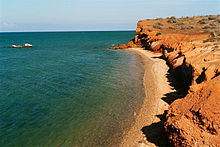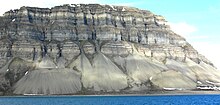Cliff
A cliff is a geographical feature consisting of a slope or abrupt vertical. Normally a cliff is referred to when it is on the coast, but those that exist in mountains, faults and river banks can also be considered as such. When a tabular coastal cliff reaches large dimensions, it is called a bluff.
Cliffs are usually made up of rocks resistant to erosion and weathering, generally sedimentary rocks such as limonite, sandstone, limestone, dolomite, although igneous rocks such as basalt or granite can also be seen in these formations.
An escarpment is a particular case of cliff, formed by the movement of a tectonic fault or a landslide. Most cliffs taper off at their base; in arid areas or under large cliffs, the slope is generally an accumulation of detached rocks, while in areas of higher humidity, the slope rocks are covered by a layer of earth compacted by moisture, forming a soil.
Many cliffs also feature waterfalls and caves carved into the base. Sometimes the cliffs die at the end of a ridge, creating unique stone structures.
The highest coastal cliff in the world is Thumbnail, which is the east face of Agdlerussakasit, located in southern Greenland, at about 1500 ms. no. m..
Other cliffs that are among the highest in the world are the Faneque cliff belonging to the municipality of Agaete on the island of Gran Canaria (Canary Islands) with 1027 m, and one located in Kaulapapa (Hawaii) with 1010 meters.
In Galicia, northwest of Spain, are the highest cliffs in continental Europe, reaching altitudes of more than 600 meters in the Garita Herbeira area.
Large and famous cliffs
While cliffs do not have to be exactly vertical, it can be ambiguous whether a particular slope is a cliff or not, as well as how much of a given slope should be counted as a cliff. For example, if there is a really vertical rock face on a very steep slope, it is possible to count only the rock face as a cliff or a combination of the two. Consequently, cliff listings are inherently uncertain.
Some of the largest cliffs on Earth are underwater. For example, an 8,000 m drop in a 4,250 m stretch is found on a ridge located within the Kermadec Trench.
The highest non-vertical cliffs in the world are the Rupal Face of Nanga Parbat and the Southeast Face of Gyala Peri, which rise approximately 4,600m above their base. According to other sources, the highest cliff in the world, about 1,340 m high, is the eastern face of the Great Trango, in the Karakoram mountains, north of Pakistan. This calculation uses a fairly strict cliff concept, as the 1,340 m figure refers to a nearly vertical wall of two stacked pillars; if you add the very steep incline, the total drop from the cliff on the east face to the nearby Dunge Glacier is almost 2,000m.
The location of the highest sea cliffs in the world also depends on the definition of "cliff" that is used According to the Guinness Book of Records, the highest is that of Kalaupapa, in Hawaii, with 1,010 m high. Another candidate is the north face of Miter Peak, which drops to 1,683 m in Milford Sound, New Zealand, which is subject to a less strict definition, as the average slope of these cliffs at Kaulapapa is about 1.7, which corresponds to an angle of 60 degrees, and the Miter Peak is similar. A more vertical drop towards the sea is found in the Maujit Qaqarssuasia (also known as "Thumbnail" or thumbnail), which is located in the Torssukátak fjord area, at the tip of South Greenland, and that falls 1,560 m almost vertically.
If the definition of cliffs refers exclusively to a truly vertical drop, Mount Thor on Baffin Island in the Canadian Arctic is generally considered the highest, at 1,370m in total height (the top 480m jutting out), and is said to be the longest vertical drop on Earth, at 1,250 m. However, other cliffs on Baffin Island, such as the Spire of the Polar Sun in Sam Ford Fjord, or others in remote areas of Greenland may be higher.
The highest cliff in the solar system may be the Verona Rupes, a fault scarp about 12 miles (20 km) high on Miranda, a moon of Uranus.
As a habitat
Cliff landforms provide unique habitat niches for a variety of plants and animals, whose preferences and needs are tailored to the vertical geometry of these types of landforms. For example, various birds have strong affinities for choosing clifftop nesting locations, often driven by the defense of these locations as well as the absence of certain predators.
Flora
The population of the rare Borderea chouardii, during 2012, existed only in two clifftop habitats within western Europe.
Contenido relacionado
Vietnamese geography
This
Geographic information system








